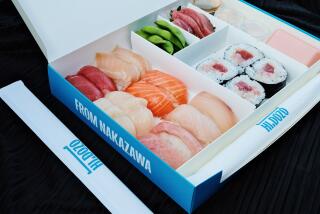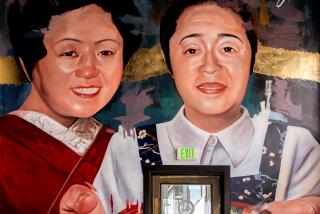Suzuki Falls Victim to Its Own Samurai
It was just two years ago that American Suzuki Motor Corp., basking in the popularity of its Samurai sport vehicle, predicted that it would soon be selling a full line of automobiles in America. By 1990, the company--best known for its motorcycles--expected to sell 300,000 cars and sport utility vehicles in this country.
Much has changed for Suzuki since then and most of it for the worse.
Sales of the Samurai have plummeted to 3,399 in the first eight months of this year from a high of 81,349 in 1987. And sales of four new models introduced in the past year have been dismal: As of Sept. 1, Suzuki had sold only 21,389 cars and sport utility vehicles.
As the crucial 1990-model season gets into full swing, American Suzuki appears unprepared.
Last Monday, American Suzuki’s president was reassigned to corporate headquarters in Japan, and three core members of the company’s American management team abruptly resigned.
The shake-up shocked Suzuki dealers, whose first shipments of 1990 vehicles were arriving that day. The company is not saying whether it plans to name replacements for the executives who resigned. The three were widely credited for the Samurai’s early success.
There have been other changes at American Suzuki’s Brea headquarters. More than 15% of the Orange County headquarters staff--or about 25 workers--were laid off earlier this year, a high-ranking executive of Suzuki’s parent company in Japan took over as chairman of the operation in July, and the company is seeking a new advertising agency as the selling season begins.
As Vice President Doug Mazza, Sales Director John Dorsey and National Sales Manager Larry Messelt were resigning last week, marketing strategies for the 1990-model season were still being developed and the company’s only advertising was on billboards. The resignations left other plans undecided and raised speculation from analysts about more resignations or layoffs.
Safety Issue
“The best anyone can do is guess at where this company is headed,” said Jeremy Anwyl, an auto industry consultant in Irvine.
The decline of Brea-based American Suzuki can be traced to June, 1988, when the publisher of Consumer Reports magazine sharply criticized the safety of the Samurai, claiming that it was more prone to rolling over than other sport utility vehicles.
Suzuki spent millions of dollars on rebates and lobbying in Washington to defend itself against the accusation. Early this year, Suzuki won vindication when a federal study concluded that the vehicle was no more susceptible to rolling over than other similar sport trucks. By March, Suzuki officials said the problem had been put to rest.
However, not only has the Samurai failed to recover, but a Suzuki spokeswoman now acknowledges that the attacks on the Samurai have also tainted the image of Suzuki’s four other vehicles.
The Sidekick--a utility vehicle similar to the Samurai--and three models of the spunky Swift subcompact car have earned praise from reviewers, but sales have been disappointing. One Swift model, the GLX, has sold fewer than 1,000 units and is being dropped from the 1990 line.
“Beyond the Samurai, people don’t have another image of Suzuki, except maybe as a motorcycle maker,” said Anwyl, president of the ad agency USP Automotive Advertising. “When people criticized the Samurai, they might as well have been criticizing the whole Suzuki name.”
Company officials declined to discuss their marketing or sales plans, which for several years were developed largely by Mazza. Industry analysts describe the next several months as a crucial period for American Suzuki to rebuild identity with consumers and with Suzuki’s U.S. dealers.
Dealers Disenchanted
“Following these resignations, if they don’t come back very strong with a lot of money, some new products and some major personnel announcements, (American Suzuki) might as well just go away,” said Lee Sattley, vice president of operations for Astro Management, which closed its Lakewood Suzuki dealership in August.
Sattley said his company, which still operates large Nissan and Mazda dealerships, decided to shut down its Suzuki operations “to stop the bleeding.” He said he expects that other dealers will likely consider doing the same in the wake of last week’s resignations.
“When you aren’t getting a return on investment, and I don’t imagine many dealers are, you look at your level of confidence in management,” Sattley said. “Now, with basically all the familiar leadership decimated, it’s pretty hard to have confidence.”
Many dealers made fast and hefty profits in 1986 and 1987 on the Samurai, which was introduced in 1985. Now they get few requests for either the Samurai or the Swift, which holds the honor as the most fuel-efficient import for 1990.
The struggles of Suzuki are similar to those faced by the West German auto maker Audi. In 1986, CBS’ “60 Minutes” aired a story that said the Audi 5000 had a tendency to suddenly and dangerously accelerate. It wasn’t until July of this year that the federal government cleared Audi in a major report, and concluded that the problem resulted from driver error.
But Audi’s sales--across the board, not just for the 5000--have fallen precipitously over the past three years. After peaking at 73,000 cars in 1985, sales fell to 23,000 last year, and analysts say Audi may never regain its 1985 sales level.
‘Identity Crisis’
“With Audi and Suzuki, once these companies were damaged, they can be vindicated and bring out the best product anywhere, but it doesn’t make much difference,” said George Peterson, president of Auto Pacific Group, a consulting firm in Newport Beach.
Suzuki’s “identity crisis,” as one analyst described it, first took its toll at the dealer level.
When Suzuki officials decided that clearing the Samurai name was the company’s top priority, most of the company’s resources were directed to that effort for several months. As a result, Suzuki’s long-time strategy of maintaining close relationships with dealers started to weaken, said Jesse Snyder, West Coast editor of Automotive News.
Snyder said that when Suzuki introduced the Samurai in 1985, the company spent a great deal of time calling on dealers and listening to their ideas and complaints. This was important in helping Suzuki build dealer loyalty.
Because Suzuki did not have a broad line of cars, the company couldn’t insist that dealers sell only Suzukis. Instead, they signed up dealers whose lots were crowded with Nissans, Toyotas, Plymouths or Fords.
After the Samurai controversy erupted, dealers continued to hang the Suzuki sign on their lots, but few customers were asking about Suzukis and few salesmen were having much luck selling the cars.
“Suzuki went to the back of the dealer’s mind, and it hasn’t come back,” Snyder said.
Trying to Respond
Bart Thomson, who was sales manager of Cormier Suzuki in Lake Forest, described Suzuki as slow to respond to dealers’ needs. Some dealers felt that they weren’t getting the answers that they needed to questions about the Samurai’s safety and its future. Cormier, which operates dealerships for several car makers, closed its Suzuki dealership in August when it sold its franchise to Superior Suzuki in Garden Grove.
Some dealers said Suzuki is now trying to be responsive again.
“They’re asking us what we think,” said John Mason, sales manager of Duarte Suzuki. Duarte sold 78 Suzukis in August and was American Suzuki’s top dealer for the month. Suzuki’s 285 dealers sold fewer than 12 cars each on average in August, a volume considered to be anemic.
As an incentive to its dealers, Suzuki in August agreed to pay half the cost of its dealers’ advertising, at least through the end of October. Right now, that advertising makes up most of American Suzuki’s advertising effort.
When Kenji Shimizu relocated from Japan to Orange County to take the newly created position of chairman of all of Suzuki’s U.S. businesses, including a struggling motorcycle operation, he said he planned to restore auto sales by increasing the company’s ad budget.
However, when the 1990 Sidekick and the three-door Swift GA were introduced Sept. 25, Suzuki had no major ad campaign to accompany the new models. While other auto makers are spending millions of dollars for sophisticated television and magazine ad campaigns, Suzuki’s only ads will be on billboards.
Agency Hunt
Suzuki put its advertising account up for review early in the summer, and had planned to name a new agency in mid-September. However, presentations from prospective agencies were abruptly canceled when Shimizu and then-president Toshiyuki Arai were called to Japan for meetings. It was Arai who was later reassigned to the home office.
Presentations by the ad agencies have been rescheduled for the middle of October, but some analysts said Suzuki may not have an ad campaign for the rest of its fiscal year, which ends March 31.
Suzuki spokeswoman Laura Segall said Suzuki may have a new campaign before April but no decision has been made and she declined to discuss the size of this year’s ad budget. At the height of the Samurai’s popularity, annual ad spending was estimated at $60 million. For fiscal 1989, the figure fell to $30 million, and this year’s total might be less than $20 million, industry observers said.
“You can have the finest cars. But if nobody knows about you, you won’t sell them,” Anwyl said.
Analysts said that for 1990, Suzuki appears to be de-emphasizing the Samurai, which for the first time is only available with a soft-top. Instead, the Sidekick and Swift are available with more options.
Heavy Competition
A new Swift three-door hatchback with a retail price of $6,400 will make Suzuki more competitive in 1990, analyst Peterson said. An early version of the car was introduced in California in July.
Snyder of Automotive News said there is still a glut of inexpensive vehicles similar to most Swift models. And the Swifts are not the cheapest or sportiest of the cars that they compete against, he said.
American Suzuki also increasingly is competing against its own parent company, Suzuki Motor Co., Ltd. in Japan. In addition to selling cars through American Suzuki, the parent company sells its Sidekick and a version of the Swift to General Motors, which includes them in its Geo line, an increasingly popular line of import cars from several manufacturers.
The Sidekick is sold as the Geo Tracker and the Geo Metro is a Swift, described by American Suzuki as a “stripped-down model.”
“What is the reason for the Swift to be marketed as the Swift?” Anwyl asked rhetorically. “There doesn’t seem to be one.”






